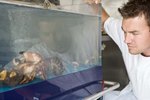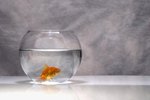
When you have any pet, you have a responsibility to keep them healthy. Hermit crabs are no exception. Both the land and marine varieties of hermit crabs are susceptible to several diseases. A bit of knowledge and some awareness of your pets can help in the event of illness.
Shell Rot
Shell rot is a problem for marine hermit crabs. In this disease, a bacterium breaks down the chitin in their exoskeletons, not their shells. This causes holes in the exoskeleton, leading to more-serious infections. In the wild, about 10 percent of hermit crabs get it every year. If you discover your pet hermit crab has this illness, the only treatment is good water quality, which helps the crab heal itself. Do not use antibiotics, which are toxic to invertebrates.
Fungus
A fungal infection looks like fuzzy spots on your land hermit crab. You should never buy a crab that has fungus, as it's very contagious. If your crab comes down with fungus, give the infected crab a saltwater bath, completely submerging the crab. You should bathe any crabs that share a habitat, even if they don't have fungus, as a precaution. Excess humidity allows fungus to thrive and spread.
Mites
Hermit crabs sometimes get mites. Quarantining new crabs for two weeks before introducing them to the main tank is the best way to prevent mites and several other problems. Mites are small but visible arthropods. If they exist in your tank and on your crab, you will know them when you see them. To treat mites, remove your crabs and give them all full-immersion freshwater baths. Sterilize everything in the tank. Boil any extra shells or ceramic ornaments. Either throw out your substrate or sterilize it by microwaving it for three minutes or baking it at 300 degrees F. Wipe down the tank with vinegar and thoroughly rinse. Never use soap, as it is toxic to crabs.
Molting
Molting is not a disease but can be easily mistaken for it. Often, people find the shed exoskeleton of a crab and think their crab is dead or dying. Closer inspection will reveal that the shed exoskeleton is an empty skin of the crab; the crab is usually hiding to protect its soft exposed parts after the molt. You may want to isolate your crab to protect it from its tank mates right after molting.
References
Photo Credits
-
Hemera Technologies/PhotoObjects.net/Getty Images



